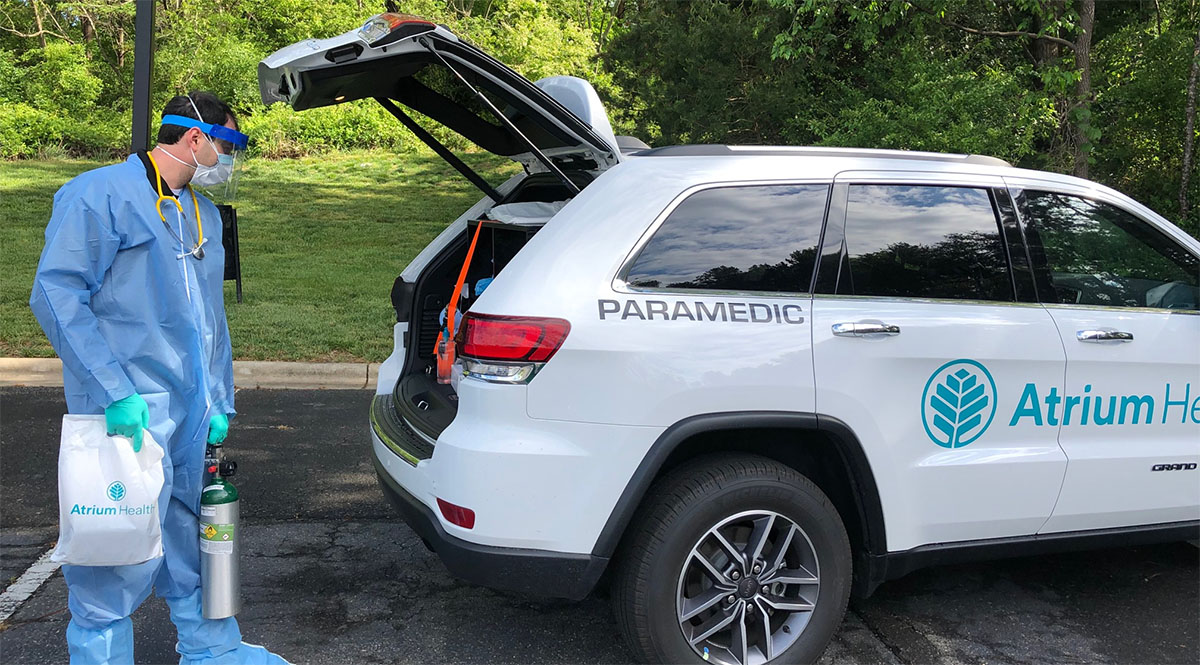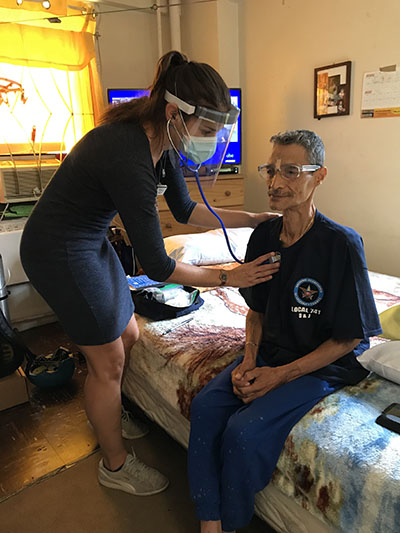
Paul Levine is a survivor. The retired accountant beat leukemia a few years ago, he has long lived with diabetes, and he managed to make it through a tough case of COVID-19 in the spring. But after a week at Mount Sinai's Beth Israel Hospital, the 86-year-old New Yorker was desperate to go home.
And go home he did, thanks to the services of Mount Sinai’s hospital-at-home program. Levine appreciated the visiting nurses, portable oxygen, and many other supports that appeared at his front door. But he’s sure his wife’s cooking contributed, too. That’s because he’d lost 20 pounds when the novel coronavirus hijacked his taste buds, and hospital food had not helped.
“I definitely credit some of my recovery to my wife’s amazing mushroom and barley soup,” he says.
The popularity of the hospital-at-home model, first launched in the 1990s in a handful of places, was starting to grow in recent years, but interest in it has skyrocketed during the COVID-19 pandemic, experts say.
Although it’s not right for everyone, it’s easy to see why many patients like the option. Hospital at home removes the awkward gowns, frequent disruptions, and irksome roommates typical of so many hospital stays.
But the model also has solid science behind it. One study showed that participants moved around nearly three times more than nonparticipants, a factor that is usually vital to recovery. It also boosted sleep time, produced fewer readmissions, and reduced mortality rates — all while significantly cutting costs.
“If hospital at home were a drug, everyone would buy it,” says David Levine, MD, MPH, who heads the Brigham and Women’s Hospital program in Boston.
In the age of COVID-19, hospital at home offers additional upsides. It can help conserve personal protective equipment (PPE), frees up beds during COVID-19 surges, keeps infected people out of hospitals, and addresses patients’ fear of contracting the disease while receiving other care.
“If hospital at home were a drug, everyone would buy it.”
David Levine, MD, MPH
Brigham and Women’s Hospital
Since the pandemic hit, Mount Sinai has tripled the number of its hospital-at-home participants. Atrium Health in North Carolina, which launched its program specifically to help COVID-19 patients, has so far cared for more than 17,000 people in their homes.
Bruce Leff, MD, runs a program at Johns Hopkins that advises institutions interested in establishing hospital-at-home programs. “I used to get maybe 10 calls a month. Now I get 20 or 30,” he says. “The field has just exploded.”
A hospital at your doorstep
Not all patients can use hospital at home. It isn’t appropriate for those who need the intensive care unit, for example, or for people who want or need a nurse just a few steps away.
But it has worked well for such serious ailments as pneumonia, congestive heart failure, diabetes complications, and dangerous skin infections.
Hospital-at-home services vary across the roughly 30 U.S. programs, but they generally include mainstays like blood tests and electrocardiograms — all delivered courtesy of visiting nurses, physicians, or paramedics. There can also be some patient self-monitoring using simple tools like in-home blood pressure kits.
The Brigham and Women’s program, created with a research grant in 2016, is among the most tech-intensive. Instead of monitoring patients using the standard vital signs monitor with snaking wires found in hospitals, providers receive the same data via a wireless patch roughly the size of a large Band-Aid. Attached to the patient’s chest, it constantly transmits helpful information such as heart rate and lung functioning to team members at the hospital. The patch offers another advantage: It can detect whether the patient has fallen.
“Because of our technology, we’re able to take much sicker patients than we otherwise could,” explains Levine, who receives a computer-generated alert if a patient’s vital signs become concerning. “We take all sorts of heart conditions,” he says. “I had a patient who was over 100 years old with a very fast heart rhythm the other day, and we were able to treat her at home.”
Levine and others note that it’s actually the programs’ low-tech features that can have the biggest impact, such as detecting aspects of a patient’s environment or habits that would go unnoticed in the hospital.
“You wonder why Mr. Smith comes back seven times for congestive heart failure when he says he’s taking all his meds. Then you go to his home and watch him take them, and you see that he doesn’t really understand” the medication regimen, says Linda DeCherrie, MD, clinical director of Mount Sinai’s program.
But what about an at-home emergency?
“We can get help to patients in minutes, whether by sending a paramedic or even someone from our team,” says Levine. Plus, well-honed criteria help ensure that his program includes only patients at a low risk of major setbacks.
“Yes, we do have very rare events,” he says, “but there are lots of problems associated with being in the hospital, too.”
COVID-19 patient Levine felt very safe in the hospital and appreciated how dedicated providers were “to keeping me on this side of mortality.” But it was hard for him to take how severely the hospital stay undermined his independence.
“At home, I could get all around my apartment with the long oxygen tubing. I could get things for myself and go to the bathroom by myself. In the hospital, you’re so dependent,” he says. “No one wants to be dependent.”
Shifting to cope with a pandemic
COVID-19 is changing the face of hospital at home.
Looking back a decade or so ago, Leff says, “This was very lonely work.” There was just a handful of programs, often offered through the Department of Veterans Affairs or as part of research studies.
Then about two years ago, interest began creeping up. “Obamacare had taken hold, and thinking about value-based care had grown,” he explains. “Health systems had already done the easier stuff” and began considering hospital at home.
Since COVID-19 hit, Leff hears about new programs practically every day. The growth is due partly to pandemic-related easing of payment-related and other regulations by government and private insurers, he notes.
But it’s not just new programs that are changing the hospital-at-home landscape. About a third of existing programs have expanded during the pandemic even as others temporarily shuttered so providers could help on hospital wards, says DeCherrie.
In her own program, staff jumped in last March to move non-COVID-19 patients out of Mount Sinai and free up much-needed beds. That represented a significant expansion for her team. Previously, they’d accepted patients only straight from the emergency department, not those who had been receiving in-patient care.
The program’s numbers soon soared. “At first, we took only non-COVID patients, but once we were granted enough PPE, we took COVID-19 patients too,” DeCherrie says. “So many of them had been in the ICU, and they were healing but still needed attention, so we brought them home to finish their last three or four days of care.”

Atrium created its program in March with a similar goal of opening up hospital beds for the hardest-hit COVID-19 patients, notes Stephanie Murphy, DO, medical director of the program. But she notes that leaders also wanted to protect other patients and staff from infected individuals and, of course, to allow patients to receive care where they are most comfortable: at home.
Atrium’s COVID-19 program has what Murphy calls two “floors”: one for less-sick patients under observation and one for acute care. At one point, the observation floor had nearly 3,000 patients, she says.
“That floor is primarily driven by our nursing staff,” who are available 24/7, Murphy explains. “Patients answer questions about their symptoms via an app or phone call. Nurses can reach out to patients who are showing red flags, and we can then help treat them more aggressively.”
Acute-level patients receive a self-monitoring kit, including a pulse oximeter to measure heart rate and oxygen uptake. Each day, they get multiple calls to check on their vitals, a virtual doctor’s appointment, and a daily in-home visit from a paramedic that can include EKGs, lab tests, and such advanced treatments as IV medications and respiratory therapies.
Ramona Reeves used the program after COVID-19 slammed her with shortness of breath, fatigue, fever, and a racking cough.
“I was stuck in my room [quarantining]. After a week, you start to panic a little. Not seeing a doctor messes with your mind,” says the 56-year-old medical scheduling coordinator. “It felt good to have someone come in and take my vital signs.”
She particularly appreciated her providers’ kindness and supportiveness. “I was so grateful that they were willing to come to my house” given that she contracted the virus early in the pandemic, before its contagiousness was better understood. “They had to go home to their own families, but they didn’t make me feel like I had the plague,” she says. “Just their friendliness made me feel a whole lot better.”
Will it last?
Proponents of hospital at home now face the question of what the future holds. Much of the answer lies in another question: How willing are insurers to pay for it?
“We have negotiated contracts with five health insurances under their commercial, Medicare Advantage, and managed Medicaid plans,” says Mount Sinai’s DeCherrie. “But there is still no payment model from standard Medicare. They are very interested, though, and I think it’s coming.”
Johns Hopkins’ Leff adds that in recent months, he’s been approached by several major commercial insurers for guidance on possible payment models. In addition, leaders of a consortium of hospital-at-home programs are working to create quality standards that could shape regulatory and reimbursement policies.
Patients are definitely interested. According to a national survey of 1,000 adults released in May, 80% of respondents said they were likely to use the service, and of those, 37% were “highly likely” to do so.
Also encouraging is the development of additional portable and remote medical tools, says Levine. Already, his team uses and is further perfecting a blood-lab device that fits in the palm of a technician’s hand and provides a rapid, on-site result.
“One day, hospitals will be just ERs, ORs, and ICUs. Everything else should get pushed out into the community.”
Bruce Leff, MD
Johns Hopkins University School of Medicine
Meanwhile, Leff hopes hospitals will increasingly appreciate the advantages of reduced brick-and-mortar investments. “The average cost [of building a hospital] is about $2 million per bed, so we’re talking about a billion dollars to build a 500-bed hospital. That’s real money,” he says. “Then you have to worry about filling those beds.”
For his part, Levine says he’d like to see hospital at home help address the dire shortages of hospitals in rural areas. He’s working toward that goal, and this month, he’s launching the first rural hospital at home, in Utah, as part of a research project.
But Leff envisions an even more dramatic future for the model nationwide.
“One day, hospitals will be just ERs, ORs, and ICUs,” he predicts. “Everything else should get pushed out into the community. That’s what we saw during the peak of the pandemic at several major medical centers,” he says. “It could be 20 years or even more, but I think that’s where it will go.”
